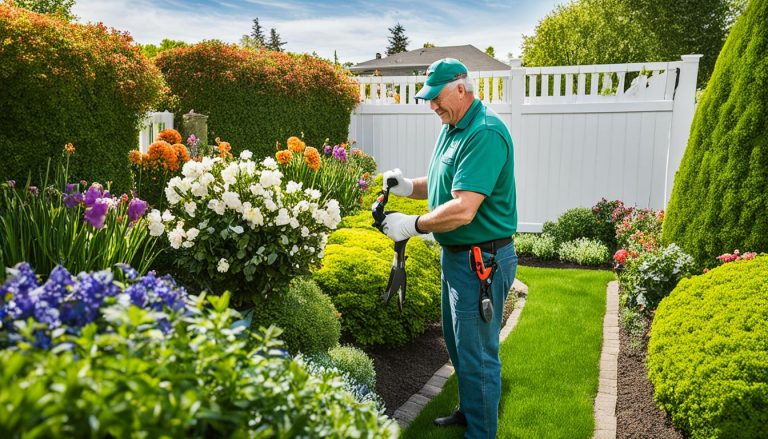Beyond the Basics: Advanced Landscape Maintenance Strategies
Welcome to our comprehensive guide on advanced landscape maintenance strategies. If you’re looking to elevate your outdoor space to new heights, you’ve come to the right place. In this article, we will provide you with expert tips and tricks to transform your grounds into a thriving and vibrant yard.
Whether you’re a seasoned gardener or just starting your landscaping journey, these advanced strategies will help you take your landscape to the next level. From enhancing soil health to implementing water conservation techniques, we’ve got you covered.
So, let’s dive into the world of advanced landscape maintenance strategies and discover how you can create an outdoor space that will be the envy of the neighborhood.
- Enhancing soil health and nutrient management
- Implementing water conservation techniques and efficient irrigation systems
- Selecting sustainable plants and practicing integrated pest management
Each section will provide you with valuable insights and actionable steps that you can easily incorporate into your own landscape maintenance routine. So, get ready to learn, implement, and see the impressive results.
Let’s get started!
Enhancing Soil Health and Nutrient Management
Creating a thriving and vibrant landscape requires more than just aesthetic appeal. It’s crucial to prioritize the health of your soil and effectively manage nutrient levels to ensure optimal growth and longevity for your outdoor space. Let’s explore some essential techniques and practices that will enhance soil health and nutrient management in your landscape.
1. Soil Testing
Before implementing any soil improvement strategies, it is essential to conduct a soil test to determine its current composition and nutrient levels. This will provide valuable insights into the specific needs of your soil and guide you in making informed decisions regarding fertilizer application and amendments.
2. Organic Matter Amendments
Adding organic matter to your soil is one of the most effective ways to enhance soil health. Organic matter improves soil structure, water-holding capacity, and nutrient availability. Incorporating compost, well-rotted manure, or leaf litter into your soil will enrich it with essential nutrients and promote beneficial microbial activity.
3. Cover Cropping
Implementing cover crops is an excellent technique for enriching your soil and preventing erosion. Cover crops such as legumes, grasses, or grains help fix nitrogen, add organic matter, suppress weeds, and improve soil structure. They also provide habitat for beneficial insects, promoting a healthy ecosystem in your landscape.
4. Crop Rotation
Crop rotation is a valuable practice that helps break pest and disease cycles while replenishing soil nutrients. By alternating the types of plants grown in different areas of your landscape, you can optimize nutrient uptake and minimize the risk of soil-borne diseases. A well-planned crop rotation schedule will benefit the overall health of your landscape.
5. Mulching
Applying mulch to your soil surface offers numerous benefits in soil health and nutrient management. Mulch conserves soil moisture, suppresses weeds, moderates soil temperature, and gradually enriches the soil as it breaks down. Organic mulches like wood chips, straw, or shredded leaves are excellent choices for improving your landscape’s soil health.
6. Proper Watering and Fertilizer Application
Establishing a suitable irrigation schedule and using appropriate fertilizers will ensure efficient nutrient management and minimize potential leaching or runoff. Deep, infrequent watering encourages deep root growth and efficient nutrient uptake. Additionally, utilizing slow-release fertilizers or organic alternatives helps provide a steady supply of nutrients to your plants without causing nutrient imbalances.
7. Composting
Composting is a sustainable method to recycle organic waste and create nutrient-rich soil amendments. By composting kitchen scraps, yard waste, and other biodegradable materials, you can reduce landfill waste and produce a valuable source of organic matter for your landscape. Incorporating compost into your soil will contribute to improved soil health and nutrient availability.
By implementing these soil-enhancing practices and adopting effective nutrient management techniques, you can create an environment that fosters healthy plant growth and a flourishing landscape. The next section will explore water conservation techniques and irrigation systems to further optimize your landscape maintenance strategies.
Water Conservation Techniques and Irrigation Systems
When it comes to maintaining a lush and healthy landscape, water conservation is key. By implementing efficient irrigation systems and practicing water-saving strategies, you can minimize water usage while still ensuring your outdoor space thrives.
One effective water conservation technique is optimizing your watering schedule. It’s important to water your plants and lawn at the right time of day to prevent evaporation. Experts recommend watering early in the morning or late in the evening when temperatures are cooler, minimizing water loss. Additionally, consider using smart irrigation controllers that adjust watering times based on weather conditions, ensuring your plants receive adequate hydration while avoiding overwatering.
“By optimizing your watering schedule, you can effectively conserve water without compromising the health and beauty of your landscape.” – Landscaping expert
Another way to save water is by implementing efficient irrigation systems. Drip irrigation systems, for example, deliver water directly to the roots of plants, minimizing waste due to evaporation and runoff. These systems can be installed below the surface or placed above ground, allowing for targeted watering and reducing water consumption.
An important aspect of water conservation is utilizing technology to your advantage. Consider installing rain sensors that detect rainfall and automatically adjust your irrigation system to skip watering when it’s unnecessary. This helps prevent overwatering and reduces water usage.

Implementing water-saving strategies and efficient irrigation systems is not only beneficial for the environment but also for your budget. By reducing water consumption, you can lower your water bills and contribute to a more sustainable future.
Benefits of Water Conservation and Efficient Irrigation Systems
| Benefits | Description |
|---|---|
| Reduced water waste | Efficient irrigation systems minimize water loss due to evaporation and runoff. |
| Savings on water bills | By using less water, you can significantly reduce your monthly water expenses. |
| Environmental sustainability | Conserving water helps preserve this valuable resource and protects ecosystems. |
| Healthy and thriving landscape | Proper watering techniques result in healthier plants and a vibrant outdoor space. |
Sustainable Plant Selection and Integrated Pest Management
Creating a beautiful and sustainable landscape requires careful consideration of plant selection and effective pest management techniques. By choosing sustainable plants, you not only enhance the aesthetic appeal of your outdoor space but also promote a low-maintenance and eco-friendly environment.
When it comes to sustainable plant selection, prioritize native species that are well-adapted to your region’s climate and soil conditions. These plants have evolved to thrive in the local environment, reducing the need for excessive water, fertilizers, and pesticides. Additionally, native plants provide habitat and food sources for local wildlife, contributing to a balanced ecosystem.
To maintain healthy plants and minimize the use of harmful chemicals, integrated pest management (IPM) techniques play a crucial role. IPM involves a comprehensive approach to pest control, utilizing environmentally friendly methods such as biological controls, cultural practices, and targeted pesticides only when necessary. By focusing on prevention, monitoring, and intervention, IPM helps keep pest populations at bay while minimizing the impact on beneficial insects and the overall ecosystem.
Incorporating sustainable plant selection and integrated pest management into your landscape maintenance strategies not only benefits the environment but also saves you time and money in the long run. By working in harmony with nature, you can create a thriving outdoor space that is beautiful, resilient, and sustainable for years to come.







